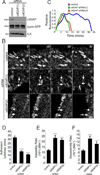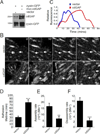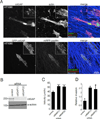CdGAP regulates cell migration and adhesion dynamics in two-and three-dimensional matrix environments
- PMID: 22907917
- PMCID: PMC4474383
- DOI: 10.1002/cm.21057
CdGAP regulates cell migration and adhesion dynamics in two-and three-dimensional matrix environments
Abstract
CdGAP is a Rac1/Cdc42 specific GTPase activating protein (GAP) that localizes to cell-matrix adhesions through an interaction with the adhesion scaffold α-parvin/actopaxin to regulate lamellipodia formation and cell spreading. Herein, we demonstrate, using a combination of siRNA-mediated silencing and overexpression, that cdGAP negatively regulates directed and random migration by controlling adhesion maturation and dynamics through the regulation of both adhesion assembly and disassembly. Interestingly, cdGAP was also localized to adhesions formed in three-dimensional (3D) matrix environments and cdGAP depletion promoted cancer cell migration and invasion through 3D matrices. These findings highlight the importance of GAP proteins in the regulation of Rho family GTPases and the coordination of the cell migration machinery..
2012 Wiley Periodicals, Inc
Conflict of interest statement
Figures








Similar articles
-
The focal adhesion-localized CdGAP regulates matrix rigidity sensing and durotaxis.PLoS One. 2014 Mar 14;9(3):e91815. doi: 10.1371/journal.pone.0091815. eCollection 2014. PLoS One. 2014. PMID: 24632816 Free PMC article.
-
CdGAP associates with actopaxin to regulate integrin-dependent changes in cell morphology and motility.Curr Biol. 2006 Jul 25;16(14):1375-85. doi: 10.1016/j.cub.2006.05.057. Curr Biol. 2006. PMID: 16860736
-
A stretch of polybasic residues mediates Cdc42 GTPase-activating protein (CdGAP) binding to phosphatidylinositol 3,4,5-trisphosphate and regulates its GAP activity.J Biol Chem. 2012 Jun 1;287(23):19610-21. doi: 10.1074/jbc.M112.344606. Epub 2012 Apr 19. J Biol Chem. 2012. PMID: 22518840 Free PMC article.
-
Tensins are versatile regulators of Rho GTPase signalling and cell adhesion.Biol Cell. 2017 Mar;109(3):115-126. doi: 10.1111/boc.201600053. Epub 2016 Nov 25. Biol Cell. 2017. PMID: 27748980 Review.
-
IQGAP1: a key regulator of adhesion and migration.J Cell Sci. 2005 May 15;118(Pt 10):2085-92. doi: 10.1242/jcs.02379. J Cell Sci. 2005. PMID: 15890984 Review.
Cited by
-
Actopaxin (α-parvin) phosphorylation is required for matrix degradation and cancer cell invasion.J Biol Chem. 2012 Oct 26;287(44):37309-20. doi: 10.1074/jbc.M112.385229. Epub 2012 Sep 6. J Biol Chem. 2012. PMID: 22955285 Free PMC article.
-
The focal adhesion-localized CdGAP regulates matrix rigidity sensing and durotaxis.PLoS One. 2014 Mar 14;9(3):e91815. doi: 10.1371/journal.pone.0091815. eCollection 2014. PLoS One. 2014. PMID: 24632816 Free PMC article.
-
CdGAP promotes prostate cancer metastasis by regulating epithelial-to-mesenchymal transition, cell cycle progression, and apoptosis.Commun Biol. 2021 Sep 7;4(1):1042. doi: 10.1038/s42003-021-02520-4. Commun Biol. 2021. PMID: 34493786 Free PMC article.
-
CdGAP/ARHGAP31 is regulated by RSK phosphorylation and binding to 14-3-3β adaptor protein.Oncotarget. 2018 Jan 10;9(14):11646-11664. doi: 10.18632/oncotarget.24126. eCollection 2018 Feb 20. Oncotarget. 2018. PMID: 29545927 Free PMC article.
-
CdGAP/ARHGAP31, a Cdc42/Rac1 GTPase regulator, is critical for vascular development and VEGF-mediated angiogenesis.Sci Rep. 2016 Jun 7;6:27485. doi: 10.1038/srep27485. Sci Rep. 2016. PMID: 27270835 Free PMC article.
References
-
- Abercrombie M, Dunn GA. Adhesions of fibroblasts to substratum during contact inhibition observed by interference reflection microscopy. Exp. Cell Res. 1975;92:57–62. - PubMed
-
- Aoki K, Nakamura T, Matsuda M. Spatio-temporal Regulation of Rac1 and Cdc42 activity during nerve growth factor-induced neurite outgrowth in PC12 cells. J. Biol. Chem. 2004;279:713–719. - PubMed
-
- Arthur WT, Noren NK, Burridge K. Regulation of rho family GTPases by cell-cell and cell-matrix adhesion. Biol. Res. 2002;35:239–246. - PubMed
-
- Bacac M, Stavenkovic I. Metastatic Cancer Cell. Annu. Rev. Path. Mech. Dis. 2008;3:221–247. - PubMed
Publication types
MeSH terms
Substances
Grants and funding
LinkOut - more resources
Full Text Sources
Research Materials
Miscellaneous

